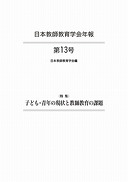13 巻
選択された号の論文の26件中1~26を表示しています
- |<
- <
- 1
- >
- >|
-
2004 年13 巻 p. 3-5
発行日: 2004/09/15
公開日: 2020/10/02
PDF形式でダウンロード (638K)
1 特集「子ども・青年の現状と教師教育の課題」
-
2004 年13 巻 p. 8-14
発行日: 2004/09/15
公開日: 2020/10/02
PDF形式でダウンロード (1353K) -
2004 年13 巻 p. 15-20
発行日: 2004/09/15
公開日: 2020/10/02
PDF形式でダウンロード (1156K) -
2004 年13 巻 p. 21-26
発行日: 2004/09/15
公開日: 2020/10/02
PDF形式でダウンロード (1193K) -
2004 年13 巻 p. 27-31
発行日: 2004/09/15
公開日: 2020/10/02
PDF形式でダウンロード (1122K) -
2004 年13 巻 p. 32-37
発行日: 2004/09/15
公開日: 2020/10/02
PDF形式でダウンロード (1056K) -
2004 年13 巻 p. 38-44
発行日: 2004/09/15
公開日: 2020/10/02
PDF形式でダウンロード (1224K) -
2004 年13 巻 p. 45-51
発行日: 2004/09/15
公開日: 2020/10/02
PDF形式でダウンロード (1294K) -
2004 年13 巻 p. 52-57
発行日: 2004/09/15
公開日: 2020/10/02
PDF形式でダウンロード (1134K) -
2004 年13 巻 p. 58-63
発行日: 2004/09/15
公開日: 2020/10/02
PDF形式でダウンロード (1317K) -
2004 年13 巻 p. 64-71
発行日: 2004/09/15
公開日: 2020/10/02
PDF形式でダウンロード (1360K)
2 研究論文
-
2004 年13 巻 p. 74-83
発行日: 2004/09/15
公開日: 2020/10/02
PDF形式でダウンロード (1647K) -
2004 年13 巻 p. 84-93
発行日: 2004/09/15
公開日: 2020/10/02
PDF形式でダウンロード (1481K) -
2004 年13 巻 p. 94-104
発行日: 2004/09/15
公開日: 2020/10/02
PDF形式でダウンロード (1460K) -
2004 年13 巻 p. 105-119
発行日: 2004/09/15
公開日: 2020/10/02
PDF形式でダウンロード (2013K)
3 教師教育の実践報告
-
2004 年13 巻 p. 122-132
発行日: 2004/09/15
公開日: 2020/10/02
PDF形式でダウンロード (1554K)
4 書評・文献紹介
-
2004 年13 巻 p. 134-136
発行日: 2004/09/15
公開日: 2020/10/02
PDF形式でダウンロード (788K) -
2004 年13 巻 p. 137-139
発行日: 2004/09/15
公開日: 2020/10/02
PDF形式でダウンロード (785K) -
2004 年13 巻 p. 140-143
発行日: 2004/09/15
公開日: 2020/10/02
PDF形式でダウンロード (891K) -
2004 年13 巻 p. 144-145
発行日: 2004/09/15
公開日: 2020/10/02
PDF形式でダウンロード (637K)
5 第13回大会の記録
【シンポジウム】
-
2004 年13 巻 p. 148-162
発行日: 2004/09/15
公開日: 2020/10/02
PDF形式でダウンロード (2506K)
【課題研究】
課題研究Ⅰ
-
2004 年13 巻 p. 162-173
発行日: 2004/09/15
公開日: 2020/10/02
PDF形式でダウンロード (2068K)
課題研究Ⅱ
-
2004 年13 巻 p. 174-181
発行日: 2004/09/15
公開日: 2020/10/02
PDF形式でダウンロード (1397K)
課題研究Ⅲ
-
2004 年13 巻 p. 181-190
発行日: 2004/09/15
公開日: 2020/10/02
PDF形式でダウンロード (1635K)
【第9回教師教育インカレゼミ・日本教師教育学会インカレ報告】
-
2004 年13 巻 p. 194-195
発行日: 2004/09/15
公開日: 2020/10/02
PDF形式でダウンロード (631K)
-
2004 年13 巻 p. contents
発行日: 2004/09/15
公開日: 2020/10/02
PDF形式でダウンロード (694K)
- |<
- <
- 1
- >
- >|
